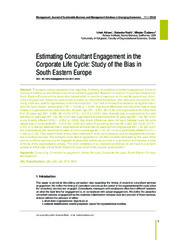Please use this identifier to cite or link to this item:
https://rfos.fon.bg.ac.rs/handle/123456789/1714Full metadata record
| DC Field | Value | Language |
|---|---|---|
| dc.creator | Adizes, Ichak | |
| dc.creator | Rodić, Dušanka | |
| dc.creator | Čudanov, Mladen | |
| dc.date.accessioned | 2023-05-12T11:10:29Z | - |
| dc.date.available | 2023-05-12T11:10:29Z | - |
| dc.date.issued | 2017 | |
| dc.identifier.issn | 1820-0222 | |
| dc.identifier.uri | https://rfos.fon.bg.ac.rs/handle/123456789/1714 | - |
| dc.description.abstract | This paper surveys perception bias regarding the timing of proactive consultant engagement. It aims to improve the efficiency and effectiveness of consultant engagement. Research is based on the primary dataset from South Eastern Europe and the secondary dataset which is used for comparison as the real life cycle phase of consultant engagement. Adizes life cycle model provided our theoretical framework. After data were checked for normality, t-test was used for hypotheses confirmation/rejection. The T-test confirmed the existence of negative bias in early life cycle phases, onesamplet (118) =-16,232, p = 0.000. Significant differences were found for bias of early phases in organisations founded less than 25 years ago (M= -0.301, SD=0.22) and organisations founded more than 25 years ago (M= -0.396, SD=0.24); t(110)= 2.072, p=0.041; also, absolute bias in organisations founded less than 25 years ago (M=1.32, SD=0.27) and organisations founded more than 25 years ago (M=1.20, SD=0.31) is significantly different t(110)= -2.204, p=0.030. Significant differences were not found between early life cycle stages bias of consultants (M= -0.374, SD=0.26) and users of consulting services (M -0.368, SD=0.22); t(117)= 0.475, p=0.636 but absolute bias in organisations with less than 25 years of chronological age (M=1.32, SD=0.27) and organisations with more than 25 years of chronological age (M=1.20, SD=0.31) is significantly different t(117)=- 1.348, p=0.180. This research finds strong bias in estimation of life cycle phase as time for engagement of proactive consulting services. The timing for consultant engagement is not often correctly estimated by the users of the service, so those services can be engaged as preventive before issues arise in organisation and become a crisis at the tip of the organisational iceberg. The main limitations of our research are that we do not have true random sample and that data is from South Eastern Europe which limits broader generalization. | en |
| dc.publisher | Univerzitet u Beogradu - Fakultet organizacionih nauka, Beograd | |
| dc.rights | openAccess | |
| dc.rights.uri | https://creativecommons.org/licenses/by-nc-nd/4.0/ | |
| dc.source | Management: Journal of Sustainable Business and Management Solutions in Emerging Economies | |
| dc.subject | South Eastern Europe | en |
| dc.subject | management | en |
| dc.subject | corporate life cycle | en |
| dc.subject | consulting | en |
| dc.subject | consultant engagement | en |
| dc.subject | Adizes life cycle | en |
| dc.title | Estimating consultant engagement in the corporate life cycle: Study of the Bias in South Eastern Europe | en |
| dc.type | article | |
| dc.rights.license | BY-NC-ND | |
| dc.citation.epage | 12 | |
| dc.citation.issue | 2 | |
| dc.citation.other | 22(2): 1-12 | |
| dc.citation.rank | M24 | |
| dc.citation.spage | 1 | |
| dc.citation.volume | 22 | |
| dc.identifier.doi | 10.7595/management.fon.2017.0015 | |
| dc.identifier.fulltext | http://prototype2.rcub.bg.ac.rs/bitstream/id/421/1710.pdf | |
| dc.identifier.rcub | conv_828 | |
| dc.type.version | publishedVersion | |
| item.cerifentitytype | Publications | - |
| item.fulltext | With Fulltext | - |
| item.grantfulltext | open | - |
| item.openairetype | article | - |
| item.openairecristype | http://purl.org/coar/resource_type/c_18cf | - |
| Appears in Collections: | Radovi istraživača / Researchers’ publications | |
This item is licensed under a Creative Commons License


